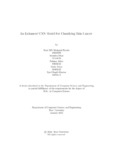| dc.contributor.advisor | Hossain, Muhammad Iqbal | |
| dc.contributor.advisor | Mostakim, Moin | |
| dc.contributor.author | Haider, Kazi MD Minhajul | |
| dc.contributor.author | Dhar, Mondira | |
| dc.contributor.author | Akter, Fahima | |
| dc.contributor.author | Islam, Sadia | |
| dc.contributor.author | Shariar, Syed Ragib | |
| dc.date.accessioned | 2022-08-29T08:38:29Z | |
| dc.date.available | 2022-08-29T08:38:29Z | |
| dc.date.copyright | 2022 | |
| dc.date.issued | 2022-01 | |
| dc.identifier.other | ID 18101708 | |
| dc.identifier.other | ID 21241070 | |
| dc.identifier.other | ID 19101642 | |
| dc.identifier.other | ID 18301232 | |
| dc.identifier.other | ID 18101571 | |
| dc.identifier.uri | http://hdl.handle.net/10361/17131 | |
| dc.description | This thesis is submitted in partial fulfillment of the requirements for the degree of Bachelor of Science in Computer Science, 2022 | en_US |
| dc.description | Cataloged from PDF version of thesis. | |
| dc.description | Includes bibliographical references (pages 41-42). | |
| dc.description.abstract | Unrepaired deoxyribonucleic acid in skin cells causes skin cancer by generating genetic
abnormalities or mutations, rising day by day. Detecting and diagnosing skin
cancer in its early stages is expensive and challenging, giving superior treatment
options. Given the severity of these issues, researchers have generated a set of early
classification techniques for skin cancer. Skin cancer is diagnosed and segregated
from melanoma by looking at the symmetry, color, size, shape, and other features of
lesions. While there are various computerized approaches for classifying skin lesions,
convolutional neural networks (CNNs) have been demonstrated to exceed standard
practices. Moreover, CNNs are a type of deep learning that has been prominent in
various fields, including medical imaging. Multiple machine learning libraries have
been used in this paper. Also, we have used five pre-trained models such as Inception
V3, VGG-19, VGG-16, Efficient Net B7, ResNet 50 models and presented our
proposed model for skin cancer classification using the HAM10000 dataset, which
is an enormous skin cancer dataset. Following that, each competent model’s image
detection categorization accuracy is evaluated by comparing and assessing. This research
reports a maximum accuracy of 85.25% for Inception V3 models within five
pre-trained models and maximum accuracy of 90.55% for our proposed model. In
terms of image detection, our experimental configuration shows that our proposed
model can attain the best classification accuracy rather than the other five pretrained
models. Our findings are helpful in providing a comprehensive comparison
and analysis of many neural networks in the categorization of skins cancer. | en_US |
| dc.description.statementofresponsibility | Kazi MD Minhajul Haider | |
| dc.description.statementofresponsibility | Mondira Dhar | |
| dc.description.statementofresponsibility | Fahima Akter | |
| dc.description.statementofresponsibility | Sadia Islam | |
| dc.description.statementofresponsibility | Syed Ragib Shahriar | |
| dc.format.extent | 42 pages | |
| dc.language.iso | en | en_US |
| dc.publisher | Brac University | en_US |
| dc.rights | Brac University theses are protected by copyright. They may be viewed from this source for any purpose, but reproduction or distribution in any format is prohibited without written permission. | |
| dc.subject | Skin cancer | en_US |
| dc.subject | CNN | en_US |
| dc.subject | Deep learning | en_US |
| dc.subject | Medical imaging | en_US |
| dc.subject | Accuracy | en_US |
| dc.subject.lcsh | Neural networks (Computer science) | |
| dc.title | An enhanced CNN model for classifying skin cancer | en_US |
| dc.type | Thesis | en_US |
| dc.contributor.department | Department of Computer Science and Engineering, Brac University | |
| dc.description.degree | B. Computer Science | |

